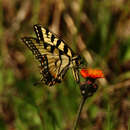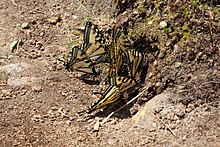pt-BR
nomes no trilho de navegação


Papilio canadensis, in Anlehnung zur englischen Bezeichnung „Canadian Tiger Swallowtail“ auch als Kanadischer Tigerschwalbenschwanz bezeichnet, ist ein Schmetterling aus der Familie der Ritterfalter (Papilionidae).
Die Falter erreichen eine Flügelspannweite von 53 bis 90 Millimetern. Ihre Grundfarbe ist gelb. Auf den Vorderflügeln befinden sich vier breite schwarze Streifen. Vom tief schwarzen Saumbereich hebt sich eine Reihe gelber Punkte ab. Auf den Hinterflügeln sind ein langer schmaler schwarzer Streifen sowie eine ebenfalls schwarze Diskoidalader zu erkennen. Aus dem dunklen Saumbereich heben sich vier große gelbe Flecke ab. Am Apex befindet sich zuweilen ein rötlicher Fleck. Der Saumbereich ist meist durch blaue Flecke sowie am Thomus durch einen roten Fleck und lange Schwänzchen charakterisiert.
Sehr selten treten nahezu einfarbig schwarze Falter auf.[1] Dabei handelt es sich ausschließlich um Weibchen.
Erwachsene Raupen sind grün gefärbt, am vorderen Teil verdickt und zeigen eine gelbe Wulst, eine helle Punktreihe sowie zwei große, dunkle, gelb umrandete und bläulich gekernte Augenflecke. Jüngere Raupen ähneln in ihrem weißbraunen Erscheinungsbild Vogelkot, wodurch sie vor Fressfeinden getarnt sind.[2]
Papilio canadensis wurde erst im Jahre 1991 von Hagen et al. aufgrund physiologischer und genetischer Unterschiede als eigenständige Art erkannt und von Papilio glaucus (Östlicher Tigerschwalbenschwanz) abgespalten.[3] Tiere aus dem Norden und dem Westen Nordamerikas sind sicher als P. canadensis anzusprechen, solche aus dem Südosten als P. glaucus. Im nordöstlichen Überlappungsgebiet kommen beide Arten vor.[4] Dort gibt es auch Hybridformen. Äußere Unterscheidungsmerkmale sind dabei kaum auszumachen. In diesen Fällen sollten Spezialisten zur Bestimmung zu Rate gezogen werden.
Papilio canadensis kommt östlich von Alaska in einem breiten Gürtel durch ganz Kanada bis zur Ostküste vor, fehlt jedoch auf Labrador. In den USA werden einige nördliche Bundesstaaten besiedelt.[5] Hauptlebensraum sind Laubwälder sowie Lichtungen und Waldränder.
Die Art bildet eine Generation im Jahr, deren Falter von Mai bis Juli fliegen.[6] Diese besuchen gerne Blüten zur Nektaraufnahme. Sie sind zur Aufnahme von Flüssigkeit und Mineralien zuweilen in Anzahl an feuchten Stellen zu finden. Die Raupen ernähren sich von den Blättern einer Vielzahl verschiedener Pflanzen, insbesondere von Birken (Betula), Äpfeln (Malus) und Pappeln (Populus). Sie verstecken sich gerne in mit Seidenfäden versponnenen Blättern. Die Puppen überwintern.
Papilio canadensis, in Anlehnung zur englischen Bezeichnung „Canadian Tiger Swallowtail“ auch als Kanadischer Tigerschwalbenschwanz bezeichnet, ist ein Schmetterling aus der Familie der Ritterfalter (Papilionidae).
Papilio canadensis, the Canadian tiger swallowtail, is a species of butterfly in the family Papilionidae. It was once classified as a subspecies of Papilio glaucus.

The wingspan of this species is 67 to 80 mm. It is very similar to the eastern tiger swallowtail, but has a noticeably smaller wingspan. Unlike it, the forewing underside, yellow marginal band is continuous. The hindwing has many orange scales on both morphs. This species has also been known to hybridize with both the eastern and western tiger swallowtail, though extremely rarely.
The caterpillar is large and green with an enlarged head. It has four yellow dots and two false eyes with bluish centers. In profile, this caterpillar appears snake-like. The immature larvae are brown and white to mimic bird droppings, making them unappealing to predators.
This butterfly is found in most provinces and territories in Canada, as its name implies. Its range extends north of the Arctic Circle in the Yukon, and to Churchill in Manitoba, Little Shagamu River in Ontario, and to Schefferville in Quebec. It does not occur in southern British Columbia, being replaced there by the western tiger swallowtail, Papilio rutulus, or in southwestern Ontario, approximately west of Toronto, where it is replaced by the eastern tiger swallowtail. It has not been reported from Labrador, but has been seen in western Newfoundland. It is seen in the northern third of the United States. Within this range, it is a very common and well-known butterfly, even more so around woodland edges. It is one of the most popular puddling species and often hundreds will gather at a single puddle.

Adults fly during spring and summer and one brood occurs. Females lay eggs singly on the host plant. The caterpillar folds the host plant's leaves and ties them together with silk; they then eat from this structure. The pupae overwinter, then emerge in May.
Papilio canadensis, the Canadian tiger swallowtail, is a species of butterfly in the family Papilionidae. It was once classified as a subspecies of Papilio glaucus.
Le Papillon tigré du Canada (Papilio canadensis) est une espèce d'insectes lépidoptères qui appartient à la famille des Papilionidae, à la sous-famille des Papilioninae et au genre Papilio.
Ce papillon diurne se retrouve au Canada et dans le nord des États-Unis. Il se nomme Canadian Tiger Swallowtail en anglais[1]. C'est une espèce qui aime particulièrement butiner les fleurs des plantes et des arbustes.
Il a été nommé Papilio glaucus canadesis par Lionel Walter Rothschild et Heinrich Ernst Karl Jordan en 1906 et jusqu’en 1991, il fut classé comme une sous-espèce du Papillon glauque. Toutefois, dès 1991, le Papillon tigré du Canada fut élevé au rang d’espèce distincte d’après des observations physiologiques et génétiques poussées[2].
Le papillon tigré du Canada est présent dans toutes les provinces du Canada à l'exception de Terre-Neuve-et-Labrador. On le retrouve également dans le nord des États américains septentrionaux et dans l'État de l'Alaska[3].
Le papillon tigré du Canada a une envergure comprise entre 53 et 80 mm. Le mâle et la femelle sont d'une couleur jaune clair rayé de noir, bordé d'une large bande noire aux antérieures comme aux postérieures. Le dessous des ailes est jaune et largement voilé d'orange et de noir[4]. Cette espèce peut être confondue avec Papilio glaucus, qui se retrouve également dans le sud de la province de l'Ontario et dans l'est des États-Unis[5].
Durant les trois premiers stades larvaires, la chenille est brune et ressemble à une fiente d'oiseau. Ce mimétisme la protège contre d'éventuels prédateurs. À partir du quatrième stade larvaire, la larve devient verte avec deux taches jaunes qui ressemblent à des yeux[2]. Juste derrière ceux-ci, on retrouve une ligne transversale jaune. La larve mature pratique la contre-illumination, une forme de camouflage qui se traduit par une pigmentation plus sombre sur la face dorsale que sur la face ventrale.
Comme toutes les chenilles de la famille des Papilionidae, les larves possèdent un organe glandulaire nommé osmeterium. Celui-ci est situé sur le dos, juste derrière la tête. Cet organe est rétractable et ressemble à deux petites cornes orangées[6]. Il dégage une odeur nauséabonde et sert à dissuader les prédateurs[7].
Après l'accouplement, la femelle pond ses œufs verdâtres sur les feuilles de la plante hôte. Ceux-ci sont déposés individuellement. La chenille peut se nourrir de plusieurs types de plantes, dont diverses espèces de saules (Salix spp.), de cerisiers (Prunus spp.), de peupliers (Populus spp.) et de frênes (Fraxinus spp.)[4].
Avant sa transformation en chrysalide, la chenille devient brun rosé. Elle se fixe à une tige à l'aide de fils de soie, puis sa cuticule se fend pour laisser émerger la chrysalide. C'est à ce stade qu'elle passera l'hiver. L'adulte émergera au printemps suivant[8]. L'espèce est univoltine et elle est présente de mai à juillet[2],[9].
Papilio canadensis se rencontre dans les boisés clairsemés, les milieux ouverts adjacents, les milieux urbains avec présence de plantes hôtes[4]. On peut observer des rassemblements de mâles sur le sol humide des chemins de terres ou de graviers, autour des mares d'eau, de boue, près d'excréments ou d'un animal en décomposition. Ils y sont présents à cause des minéraux (ex : sodium), qu'ils absorbent à l'aide de leur trompe[10]. L'adulte se nourrit de nectar et butine les fleurs de nombreuses espèces de végétaux.
Selon Handfield (1999)[10] :
Les populations de l'espèce sont relativement stables. L'espèce peut être rare dans les limites de sa répartition géographique[3].
Le Papillon tigré du Canada (Papilio canadensis) est une espèce d'insectes lépidoptères qui appartient à la famille des Papilionidae, à la sous-famille des Papilioninae et au genre Papilio.
Ce papillon diurne se retrouve au Canada et dans le nord des États-Unis. Il se nomme Canadian Tiger Swallowtail en anglais. C'est une espèce qui aime particulièrement butiner les fleurs des plantes et des arbustes.
Papilio canadensis is een vlinder uit de familie van de pages (Papilionidae).
Deze vlinder leeft in Noord-Amerika, in Alaska, Canada en het noorden van de Verenigde Staten.
Papilio canadensis gebruikt verschillende bomen als waardplant, waaronder berk (Betula), populier (Populus), Amerikaanse vogelkers (Prunus serotina), appel (Malus) en Corylus. De vrouwtjes leggen de eieren één voor één op de bladeren van de waardplant en de rupsen leven tussen samengesponnen bladeren. De rupsen verpoppen voor de winter en overwinteren in deze fase, om vanaf mei uit te vliegen. Er is één generatie die afhankelijk van de locatie tot halverwege augustus vliegt.
De vlinder wordt gevonden in loofbossen en gemengde bossen, langs bosranden en in parken en tuinen. Boven de boomgrens wordt de soort gevonden op toendra's in de buurt van dwergwilgen en andere struiken.
De soort werd voorheen beschouwd als een ondersoort van Papilio glaucus, maar is door Hermann August Hagen et al. in 1991 opgewaardeerd tot de rang van volwaardige soort. Op plaatsen waar beide soorten voorkomen is hybridisatie met Papilio rutulus vastgesteld, maar dit wordt slechts zelden waargenomen.
Papilio canadensis là một loài bướm ngày thuộc họ Papilionidae. Nó từng được xếp thành một phụ loài của Papilio glaucus.
Sải cánh dài 67 đến 80 mm. Có hai dạng của con trưởng thành màu vàng và màu đen, tuy nhiên dạng màu đen khá hiếm. Loaa2i này rất giống với loài Papilio glaucus (Eastern Tiger Swallowtail) và có đôi cánh nhỏ hơn rõ.
SÂu có màu lục, lớn với đầu to. Nó có 4 đốm vàng và 2 mắt giả với màu xanh nằm ở giữa. Khi nhìn ngang nó rất giống với hình con rắn. Ấu trùng chưa trưởng thành có màu nâu và trắng giống phân chim để tránh các loài săn mồi.
Chúng phân bố khắp các tỉnh và vùng lãnh thổ của Canada. Dải phân bố nó kéo dài đến phía bắc của vòng Bắc Cực ở Yukon, và đến Churchill ở Manitoba, Little Shagamu River ở Ontario, và đến Schefferville ở Quebec.
COn trưởng thành bay suốt mùa xuân và hè và có một đợt.
|coauthors= bị phản đối (trợ giúp)
Papilio canadensis là một loài bướm ngày thuộc họ Papilionidae. Nó từng được xếp thành một phụ loài của Papilio glaucus.
Парусник канадский[1] (лат. Papilio canadensis) — дневная бабочка из семейства парусников или кавалеров (лат. Papilionidae).
Бабочка крупных размеров с размахом крыльев самцов 65—73 мм, самок — 76—80 мм. Передние крылья треугольные, широкие, с заостренной вершиной, их наружный край ровный. Задние крылья удлиненно-овальные, с вогнутым анальным краем. Общий фон крыльев желтый или бело-жёлтый. На передних крыльях имеется характерный черный рисунок из полных и неполных перевязей, количество которых достигает 7. Перевязи полные, остальные занимают от 1/4 до 1/2 ширины крыла. Задние крылья с узкой полной перевязью, черным дискоидным штрихом и широкой субмаргинальной перевязью с округлыми пятнами из синих чешуек. Задние крылья имеют «хвостики». На нижней стороне задних крыльев в субмаргинальной перевязи обычно находятся размытые пятна из голубых и синих чешуек. На переднем крыле жилка R3 берет начало от центральной ячейки, М1 от середины дискальной жилки. Сu ствол соединен с анальной жилкой тонкой, косо идущей перемычкой.
Вид встречается в большинстве провинций и территорий в Канаде, как и предполагает его название. Его ареал простирается к северу от полярного круга в Юконе к Черчилль в Манитобе и Квебеке. Не встречается в южной части Британской Колумбии, будучи замененным там Papilio rutulus. Также обитает в США — Аляска и северные штаты[2].
За год развивается два поколения. Время лёта первого поколения — май-июнь, второго — июль-август.
Гусеницы развиваются на различных древесных лиственных породах, таких как Betula, Populus, Prunus, Malus.
Парусник канадский (лат. Papilio canadensis) — дневная бабочка из семейства парусников или кавалеров (лат. Papilionidae).